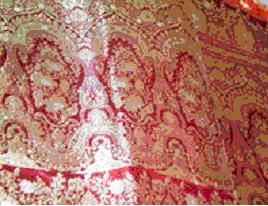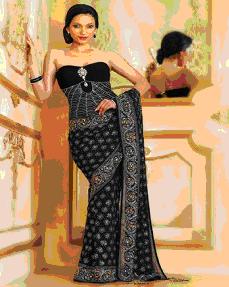Shri. Devender Singh, B.Tech (Textiles),LLB.,MBA
[This article appeared in one of the issue of Silk Mark Vogue]
Saree is the national dress of Indian women and plays an integral part in a woman’s life. They are the most popular choice for Indian women and are preferred taking into consideration Indian values, ethos and tradition. Banarasi Saree is an Indian woman’s coveted possession. For a long time Banarasi Saree has been an important part of the Indian bride wardrobe and rarely fails to flatter a woman, making her feel delicate and feminine. Varanasi (or Banares) is one of the most prominent centres of silk handloom weaving in India. The most famous product of Varanasi’s handlooms is the Banarasi silk saree, which is most in demand in weddings as well as bridal dress.
History of Banares Sarees
In fact, the tradition goes far back that sarees are mentioned in the Mahabharata (one of the two epics that play an important part of Hindu mythology), which dates between 1000 and 300 B.C. Indian saree market divides itself broadly into two; traditional bridal and designer segments.
When we talk about wedding or bridal sarees, the first kind of saree strikes in our mind is Banarasi sarees that comes in various designs, colours and textures such as embroidered Banarasi sarees, silk Banarasi sarees, designer Banarasi sarees, cutwork sarees, Butidar sarees, tissue sarees, etc. On the occasion of wedding ceremony an Indian bride clad in Banarasi designer saree complete with her solah sringar, that the looks like are beyond description.
These stunning sarees are woven in Varanasi, the oldest city in the world. In ancient times, weavers of Indian Banarasi sarees took inspiration for designs from Jasmine, Thousand Emeralds, Marigold flower, Betel nut leaf, Diagonal stripes, Corner-motif with a mango flower etc.
Features
The famous Varanasi saree made in the holy city of Banaras in the state of Uttar Pradesh and since the ancient times is ranked among the finest traditional sarees of India. These sarees are quite heavy due to its rich embroidery and are donned by Indian women only during special occasions like wedding, parties and festivities.
The zardozi work and other thread embroidery will make this saree look elegant, classic yet fashionable. Heavy sequins, beads, and buttas will add glamour and shimmer to the saree. You can also grab a net and Banarasi combined wedding saree for marriages. Colors like maroon, brown and red in combination with green and golden will definitely stand out uniquely enhancing your stature. Banarasi silk sarees are traditionally made in four varieties: pure silk (Katan), organza (Kora), Georgette saree, and Shatir saree. Traditional designs of the brocade include jasmine (chameli), thousand emeralds (panna hazar), marigolds (genda buti), betel nut leaves (paan buti), diagonal stripes (tircha) and the corner motif with a mango flower (konia). Originally the sarees were embellished with threads made from real gold and silver for use by the royal family. In modern times, this has been replaced by gold and silver-colored thread, making the sarees affordable for the general population.
Created in eye-catching shades and pattern, the Banarasi sarees of India are so famous today that they are exported all over the world. Woven on the handloom, attached with dobby or Jacquard mechanism, normally three people are required to make one Varanasi saree. Production of a Banarasi silk saree may take 15 days to six months to complete depending upon the intricacy of the designs. Banarasi saree manufacturing hubs are located in areas like Varanasi, Gorakhpur and Azamgarh.
Making of a Banarasi Silk Saree
An ideal Banarasi Saree comprises of around 5600 thread wires, all of them within 45-inch wide. In case of weaving the warp, the craftsmen make the base, which is around 24 to 26 m long. One of the most important aspects of weaving Banarasi silk sarees of India is the teamwork involved. Typically, three weavers are involved in the creation of the saree. One of them weaves the saree, while the second one is engaged at the revolving ring, where bundles are created and the third in assisting the border designing.
At the time of bundling a new process of designing the motifs begins. For creating design boards, an artist sketches the design on a graph paper, along with color concepts. Before selecting the final design, punch cards are created. A single design of an Indian Banarasi saree requires hundreds of perforated cards for the implementation of the idea. Different threads and colours are used on the loom to knit the prepared perforated cards. The knit perforated cards are then paddled in a systematic manner. This is done to ensure that the main weaving picks up the right colors and pattern.
Resurgence of Banarasi silk Sarees
Reports suggest that Indian silk is being exported to around 200 countries and the demand is increasing steadily particularly from the American and the European countries. India stands second only to China in silk production. Varanasi is known for its silk a time-tested icon of craftsmanship. The Banarasi silk saree industry is the mainstay of the holy city and adds considerably to the Indian silk export basket.



Nice blog for the marriage and more different saree for this thank for this information?